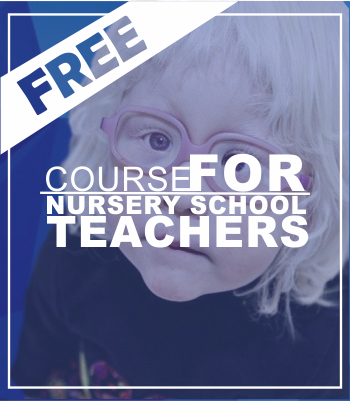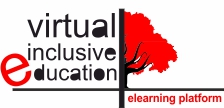
We offer a virtual course, easily accessible through an e-learning platform, to train pre-primary education teachers from existing centers so they can transform their classrooms into inclusive ones, for children between 1 to 6 years old with mild to severe visual impairment.
This course is based on the conviction that Integrated Education offers more possibilities towards children’s psychosocial development than a segregated one. The goal of this type of education is the inclusion of students with visual impairment, so they are capable of participating and interacting normally with other children without visual disabilities, and also competing in the same productivity and efficiency conditions in the future. Therefore, this course do not focus on early childhood education curricular issues, but it provides essential training to work with students with special needs through an innovative methodology that tries to fully integrate these students along with non-visually impaired students so they develop the social skills and self-confidence that will be paramount for, in the short term, their access to primary education, and for their social and labor inclusion in the future.
BASIC INFORMATION
| Number of Didactic Units: | 10 |
| Number of downloadable materials: | 16 |
| Estimated number of hours to complete the course: | 250 |
| Number of pages of downloadable material: | 284 |
COURSE STRUCTURE
The contents of the course will be structured in:
BLOCK 1: A teacher training plan for the development of the psychomotor, cognitive, social-emotional, and manual-artistic areas of the beneficiaries in standard schools.
BLOCK 2: Support Documents, Technical Advice to the schools’ staff.
BLOCK 3: Plan for the Diffusion and Extension of the services.
COURSE CONTENTS
| 1. TOPIC 1: WHAT IS THIS COURSE FOR? | |
| 1.1. Objectives of this course. | |
| 1.2. Characteristics of this course. | |
| 1.2.1. Educational competences of the course | |
| 1.2.2. Users of the course | |
| 1.2.3. Methodology of the course | |
| 1.2.4. Contents of the course | |
| 1.3. Evaluation and certification of the course. | |
| 1.4. Legislative framework in educational matter. | |
| 1.4.1. European Legislation in educational matter | |
| 1.4.2. Inclusive education in Spain, Italy and Norway | |
| 1.5. Bibliography | |
| BLOCK 1. TEACHER TRAINING PLAN | |
| 2. TOPIC 2: UNDERSTANDING LOW VISION | |
| 2.1. Basic concepts and general aspects to have in mind. | |
| 2.2. What is low vision? | |
| 2.3. Two genetic conditions linked to low vision: | |
| 2.3.1. Albinism. | |
| PDF – Characteristics of Albinism. | |
| 2.3.2. Aniridia. | |
| PDF – Characteristics of Aniridia. | |
| 2.4. The importance of early attention in low vision. | |
| 2.4.1. Methodologies for early attention. | |
| 2.4.2. At home. | |
| 2.4.3. At school. | |
| 2.5. Audiovisual materials. | |
| 2.6. Bibliography. | |
| 3. TOPIC 3: LOW VISION IN EARLY EDUCATION CLASSROOMS | |
| 3.1. Previous knowledge. | |
| 3.2. Orientation and mobility. | |
| 3.2.1. Specific recommendations for the teacher and the family. | |
| 3.3. Daily life abilities. | |
| 3.3.1. Specific recommendations for the teacher and the family. | |
| 3.4. Evolving development of students with low vision. | |
| 3.4.1. General development. | |
| 3.4.2. Perceptive-sensor development. | |
| 3.4.3. Psychomotor development. | |
| 3.4.4. Cognitive development. | |
| 3.4.5. Affective-emotional development. | |
| 3.4.6. Communication, language, and socialization. | |
| 3.5. Activities. | |
| 3.6. Bibliography. | |
| 4. TOPIC 4: NEW TECHNOLOGÍES AS A MEANS OF INCLUSION IN THE CLASSROOM | |
| 4.1. ICTs and inclusive education. | |
| PDF – Benefits of the inclsuion of the students with special educational needs. | |
| 4.2. ICTs as an inclusive resource for pre-primaryEducation. | |
| 4.3. Digital pedagogies. | |
| 4.4. Activities. | |
| 4.5. Bibliography. | |
| 5. TOPIC 5: DIGITAL METHODOLOGY IN THE INCLUSION OF EARLY CHILDHOOD STUDENTS IN THE CLASSROOM | |
| Guide on the methodological use of the games and APP in the classroom. | |
| – O2: The educational game. | |
| 6. TOPIC 6: ACTIONS OF THE EARLY EDUCATION TEACHER REGARDING LOW VISION IN THE CLASSROOM | |
| 6.1. Objectives to reach in pre-primary Education. | |
| PDF – Specific basic competences for low vision in pre-primary education: 160 items. | |
| 6.2. Recommendations. | |
| 6.3. The inclusive classroom. | |
| 6.3.1. Educational environments. | |
| 6.3.1.1. Educational needs derived from low vision (SEN). | |
| 6.3.1.2. The reality of the student with low vision in the classroom. | |
| 6.3.2. Inclusice educational community | |
| 6.3.2.1. Guidelines for teachers new to low vision and its characteristics and requirements. | |
| 6.3.2.2. Support items (specific support devices). | |
| 6.3.2.3. Students with low vision and their relationship with their peers. | |
| 6.4. Curricular adaptations | |
| 6.4.1. Types of intervention. | |
| 6.4.2. Individual adaptations. | |
| 6.4.2.1. Acces adaptations. | |
| 6.4.2.2. Properly curricular adaptations. | |
| 6.5. Development of the curricular adaptation. | |
| 6.6. Collaboration of the teachers with the families. | |
| 6.7. At the other side of the curricular adaptation | |
| 6.7.1. Recommendations for the work in the classroom. | |
| 6.7.2. Recommendations for the activities outside the classroom. | |
| 6.8. Activities. | |
| 6.9. Bibliography. | |
| BLOCK 2. SUPPORT DOCUMENTS, TECHNICAL ADVICE TO THE SCHOOLS’ STAFF | |
| 7. TOPIC 7: ACTIONS OF THE SCHOOL REGARDING LOW VISION IN EARLY CHILDHOOD CLASSROOMS | |
| 7.1. Diversity Attention plan (DAP). | |
| 7.2. Specific adaptations to have in mind for the development of the DAP. | |
| 7.2.1. Curricular adaptations of the school. | |
| 7.2.2. Curricular adaptations of the classroom. | |
| 7.3. Collaborations of the school with associations. | |
| 7.4. Activities. | |
| 7.5. Bibliography. | |
| 8. TOPIC 8: RESOURCES FOR TEACHERS | |
| 8.1. Curricular adaptation models. | |
| 8.1.1. Reference models. | |
| 8.1.2. Case study. | |
| PDF – Proposal of pre-primary education curricular adaptation model. | |
| 8.2. Educational resources. | |
| 8.2.1. Stimulation programs. | |
| 8.2.2. Visual stimulation activities. | |
| 8.2.3. Specific electronic resources. | |
| 8.3. Activities. | |
| 8.4. Bibliography. | |
| BLOCK 3. PLAN FOR THE DISSEMINTAION AND EXTENSION OF THE SERVICES | |
| 9. TOPIC 9: BRIDGES TOWARDS PRIMARY EDUCATION | |
| 9.1. Adaptations of access to the school curriculum. | |
| 9.1.1. Knowledge of the natural, social and cultural environment. | |
| 9.1.2. Art education. | |
| 9.1.3. Sports education. | |
| 9.1.4. Language and literature. | |
| 9.1.5. Foreign languages. | |
| 9.1.6. Math. | |
| 9.2. ICTs (information and communication technologies) and tiflotechnology. | |
| 9.2.1 Access to information in a computer. | |
| 9.2.2. Access to the internet. | |
| 9.2.3. Access to the contents trough digital technologies in the school. | |
| 9.3. Activities. | |
| 9.4. Bibliography. | |
| 10. TOPIC 10: THE ERASMUS PLUS PROGRAMME AS A TOOL FOR THE EDUCATIONAL INCLUSION OF STUDENTS WITH LOW VISION. | |
| 10.1. Explanation of the program. | |
| 10.2. Ideas for projects with low vision students. | |
| 10.3. Tools of the program for teachers of early childhood education. | |
ACCESS TO THE COURSE
You have two options to access to the course:
ACCESS TO THE ELEARNING PLATFORM
This course is free and open access, however if you want a personalized learning and obtain certification and digital badge, it will only be necessary to register. If you prefer to access as a guest to see the possibilities offered by this course, please access directly through the login button in VIE platform, with the following information:
(User and password)
ACCES FOR TEACHERS
FIRST CYCLE OF PRE-PRIMARY EDUCATION: Guest_teacher_03
SECOND CYCLE OF PRE-PRIMARY EDUCATION: Guest_teacher_36
ACCES FOR FAMILY MEMBERS OR PEOPLE INTERESTED IN THE TOPIC
FIRST CYCLE OF PRE-PRIMARY EDUCATION: Guest_family_03
SECOND CYCLE OF PRE-PRIMARY EDUCATION: Guest_family_36
DOWNLOAD THE CONTENTS OF THE COURSE



